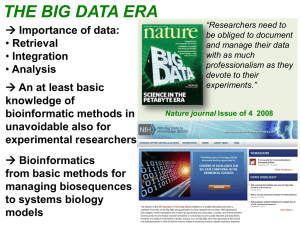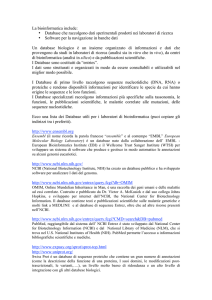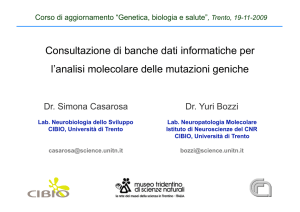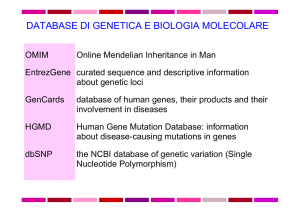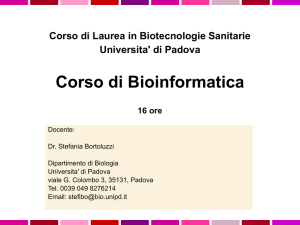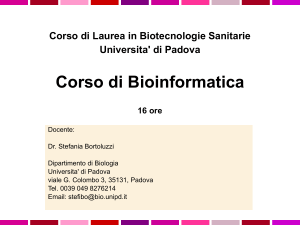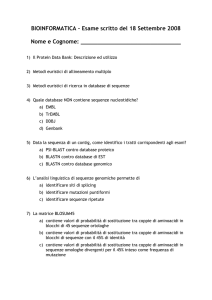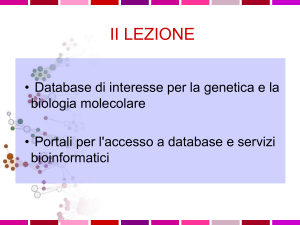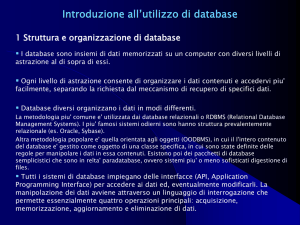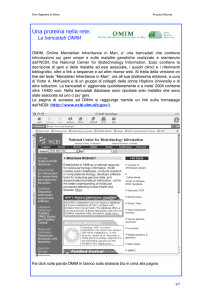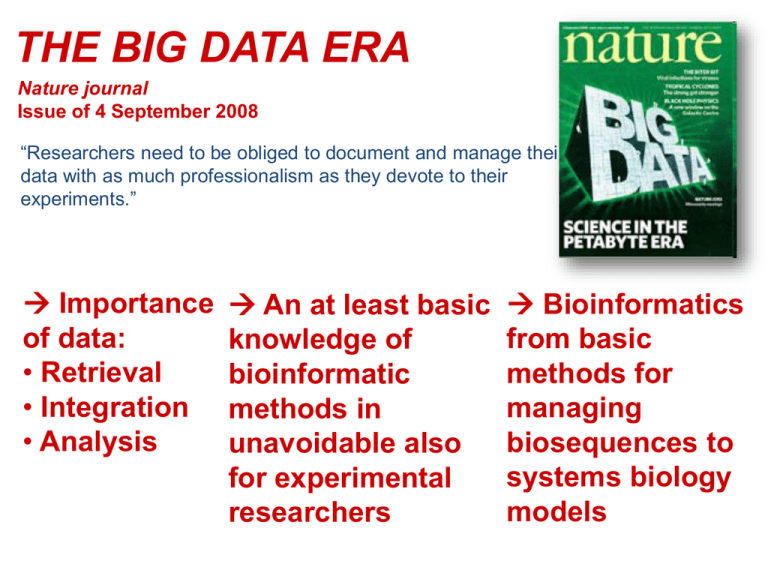
THE BIG DATA ERA
Nature journal
Issue of 4 September 2008
“Researchers need to be obliged to document and manage their
data with as much professionalism as they devote to their
experiments.”
Importance
of data:
• Retrieval
• Integration
• Analysis
An at least basic
knowledge of
bioinformatic
methods in
unavoidable also
for experimental
researchers
Bioinformatics
from basic
methods for
managing
biosequences to
systems biology
models
DATABASES AND DATA RETRIEVAL
Biosequences and Gene-related info
DATABASE PRIMARI
DATABASE DI SEQUENZE NUCLEOTIDICHE
Collezioni di singoli record, ognuno dei quali contiene un tratto di DNA o
RNA con delle annotazioni. Ogni record viene anche chiamato ENTRY, e ha
un codice che lo identifica univocamente (ACCESSION NUMBER).
Le tre principali banche dati primarie di sequenze nucleotidiche sono:
EMBL nucleotide database, ora gestita dall’EBI (1980)
EMBL = European Molecular Biology Laboratory (Heidelberg)
EBI = European Bioinformatics Institute (Hinxton, UK)
GenBank = banca dell NIH gestita dal NCBI (1982)
NIH = National Institutes of Health (Stuttura USA)
NCBI = National Center for Biotechnology Information, Bethesda, Maryland
DDBJ = banca DNA giapponese (1986)
DDBJ = DNA DataBase of Japan
SCAMBIO DI DATI Nel 1988, i gruppi responsabili dei 3 database si sono
organizzati nell’International Collaboration of DNA Sequence Databases per
utilizzare un formato comune e scambiarsi giornalmente le sequenze.
DATABASE DI SEQUENZE NUCLEOTIDICHE – GenBank
SUBMISSION DIRETTA La gran parte delle sequenze finisce in
uno dei tre database perché l’autore (il laboratorio dove tale
sequenza é stata ottenuta) la invia direttamente. La sequenza
viene quindi inserita e il record corrispondente resta di proprietà
solo di quel database, l’unico con il diritto di modificarlo. Il
database che riceve la sequenza la invia poi agli altri due. Circa il
98% delle sequenze in un database sono presenti anche negli altri
due.
ANNOTAZIONE Ci sono poi anche degli “annotatori” che
prendono le sequenze dalle riviste scientifiche e le trasferiscono
nel database.
Problema della ridondanza
There are specialized, streamlined procedures for batch
submissions of sequences, such as EST, STS, and HTG
sequences (High-throughput sequencing).
DATABASE PRIMARI
DATABASE DI SEQUENZE PROTEICHE
SWISS-PROT
Database di sequenze proteiche annotate, “scarsamente”
ridondanti e cross-referenced
Contiene TrEMBL, supplemento a SWISS-PROT costituito
dalle sequenze annotate al computer, come traduzione di
tutte le sequenze codificanti presenti all’EMBL
TrEMBL contiene due sezioni:
SP-TrEMBL, sequenze da incorporare in SWISSPROT, con
AC.
REM-TrEMBL, remaining (immunoglobuline, proteine
sintetiche, ...), senza AC.
TrEMBLnew, generato ogni settimana.
DATABASE SECONDARI
UniProt (Universal Protein Resource)
Il piu’ grande catalogo di informazioni sulle proteine. Contiene
informazioni sulla sequenza e sulla funzione di proteine ed e’
ottenuto dall’insieme delle informazioni contenute in SwissProt, TrEMBL e PIR.
UniProt
http://www.uniprot.org/uniprot/
UniProt Knowledgebase, due parti:
•Records annotati manualmente, informazioni dalla letteratura
(UniProtKB/Swiss-Prot)
•Records risultato
di analisi
computazionali,
in attesa di
annotazione
completa
(UniProtKB/TrEMBL).
DATABASE DI GENETICA E BIOLOGIA MOLECOLARE
OMIM
Online Mendelian Inheritance in Man
EntrezGene curated sequence and descriptive information
about genetic loci
GenCards
database of human genes, their products and their
involvement in diseases
HGMD
Human Gene Mutation Database: information
about disease-causing mutations in genes
dbSNP
the NCBI database of genetic variation (Single
Nucleotide Polymorphism)
DATABASE DI GENETICA E BIOLOGIA MOLECOLARE
OMIM
http://www.ncbi.nlm.nih.gov/entrez/query.fcgi?db=OMIM
EntrezGene
http://www.ncbi.nlm.nih.gov/entrez/query.fcgi?CMD=search&DB=gene
GenCards
http://bioinformatics.weizmann.ac.il/cards/
HGMD
http://www.hgmd.cf.ac.uk/ac/index.php
dbSNP
http://www.ncbi.nlm.nih.gov/projects/SNP/
OMIM
Online Mendelian Inheritance in Man
Catalogo di geni umani e malattie genetiche (Dr. Victor A.
McKusick, Johns Hopkins + NCBI)
Contiene informazione testuale, riferimenti bibliografici e links
a MEDLINE, sequenze e ad altre risorse
OMIM gene map
Posizioni di mappa citogenetica di geni-malattia e altri geni
descritti in OMIM
OMIM morbid map
Posizioni di mappa citogenetica di geni-malattia indicizzati in
OMIM
Use OMIM
to explore
Rett
syndrome
There are entries
for both the
disease and the
gene
OMIM number
Link to NCBI map viewer
OMIM
Varianti alleliche
stesso ID piu’ un altro numero di 4 cifre.
Sono MUTAZIONI CHE CAUSANO MALATTIE
ENTREZ GENE
Interfaccia unificata per cercare informazioni su
sequenze e loci genetici. Presenta informazioni sulla
nomenclatura ufficiale, accession numbers, fenotipi,
MIM numbers, UniGene clusters, omologia, posizioni
di mappa e link a numerosi altri siti web.
ENTREZ GENE
ENTREZ GENE
ENTREZ GENE
DATABASE SECONDARI
ENTREZ - Information retrieval system
• E' stato sviluppato all’NCBI (National Center for Biotechnology
Information, USA) per permettere l'accesso a dati di biologia molecolare
e citazioni bibliografiche.
• Sfrutta il concetto di “neighbouring”: possibilita' di collegare tra loro
oggetti diversi di database differenti, indipendentemente dal fatto che essi
siano direttamente “cross-referenced”.
• Tipicamente, ENTREZ permette l'accesso a database di sequenze
nucleotidiche, di sequenze proteiche, di mappaggio di cromosomi e di
genomi, di struttura 3D e bibliografici (PubMed).
PubMed
Bookshelf
}
Overview of the whole
Genome Browser page
(mature release)
Genome viewer section
Groups of data
Mapping and Sequencing Tracks
Genes and Gene Prediction Tracks
mRNA and EST Tracks
Expression and Regulation
Comparative Genomics
ENCODE Tracks
Variation and Repeats

